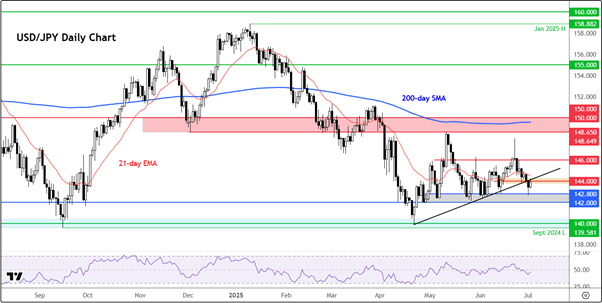SoftBank Group Q2 profit blows past expectations; sells Nvidia stake for $5.8 bln
- USD/JPY clings to key support—but one soft data print could tip it over.
- With Powell staying vague and ADP missing badly, dollar bears are circling.
- If 142 breaks, 140 may come into view fast—but choppy waters lie ahead.
- Looking for more actionable trade ideas? Subscribe now to unlock access to InvestingPro’s AI-selected stock winners for up to 50% off amid the summer sale.
The USD/JPY recovered its entire losses from the day before when it had dropped to test its lowest point since early June below 143.00. Though the pair is now back inside the chop zone around 144.00 handle, the path of least resistance remain to the downside, owing to a strengthening bearish trend for the US dollar.
The greenback has fallen to multi-year lows against several major European currencies including the pound, euro and more noticeably the franc, but it has managed to hold steady against the Japanese yen for the time being, with the 142.00-142.50 area offering strong support on multiple occasions in recent months. But the more a key level is tested, the more likely we will see an eventual breakdown. So, is the USD/JPY forecast going to change to being decisively bearish? Well, it will need to break this key support zone before potentially heading towards 140.00 and lower. For now, the dollar is making a bit of recovery, but that could easily change in the coming days – especially if incoming US data disappoints expectations. Today’s poor ADP reading was a prime example.
Dollar Rebounds on US Data but Path Forward Not Clear
The US dollar index has managed to find some support after falling to its lowest level since February 2022 yesterday. The greenback has found some support on the back of Tuesday’s US data releases when JOLTS job openings and ISM manufacturing both came in stronger than expected, offering a lift to a dollar still labouring under an asymmetric bearish tilt. On the docket today, we have ADP payrolls (which has just been released, showing a print of -33K vs. +99K), final House approval for Trump’s “Big Beautiful Bill”, as well as potential tariff posturing ahead of the 9 July deadline. On Thursday, we will have plenty more US data, including the monthly non-farm payrolls report. These upcoming events means there’s potential for increased volatility in the next few days across the FX space. Though this may imply that there are equal risks to both the upside and downside dollar directions, I will still lean towards the bearish side of things for the greenback owing to the underlying trend and negative sentiment.
Dollar Bears Need Soft Data to Justify Bearish Bets
Yesterday’s saw Fed Chair Jerome Powell stick to script in Sintra, reiterating a data-dependent stance that leaves the dollar finely attuned to labour and inflation releases. It is worth pointing out that he declined to rule out a July cut – meaning a very soft jobs print tomorrow could quickly revive market bets on near-term easing. That would be enough, in my view, to cause the USD/JPY direction to turn sharply lower and move near 140.00 zone.
That said, yesterday’s numbers went the other way. May’s JOLTS data exceeded forecasts, while ISM manufacturing ticked higher, with a rebound in prices paid sub-index pointing to increased inflationary pressures. These data releases aren’t game-changers, but they hint at sticky inflation and a still-resilient labour market, giving the Fed less cause to act soon, despite pressure from the White House. It can therefore be argued that markets may have leaned too far dovish, and that the dollar could regain its footing if inflation picks up. Put another, the dollar bears need to see the release of negative data to justify their bearish bets against the dollar.
In as far as today’s data is concerned, consensus for the ADP was to rebound to 99K from 37K the month before. Instead, we got a negative 33K print. While it’s no oracle for official payrolls, market have moved a little sharply on the back of this sharp miss. Tariff threats also loom, with Trump sticking to a 9 July deadline. While markets suspect another last-minute climbdown, any renewed trade tension still poses a headwind for the dollar.
USD/JPY Technical Analysis
From a technical point of view, the USD/JPY is in an overall bearish trend given the fact that price remains below its key moving averages like the 50 or 200 day. Even the 21-day exponential average is now back above current prices to suggest the near-term trend is also starting to turn. With a short-term bullish trend line also broken yesterday, this has added another layer of bearish flavour to the mix.
Figure 1 Source: TradingView.com
That said, support at 142.80-142.00 area needs to give way now for the trend to gather momentum. So far, this area has held on multiple occasions in recent weeks, and this was again the case yesterday as rates bounced right off this important support area. Therefore, a clean break below this area is now needed to provide fresh bearish momentum and pave the way for a potential drop to the next key support area around 140.00.
Otherwise, expect continued choppy price action in the near-term outlook. Resistance is now seen around 144.00, marking the underside of the short-term trend line that has just been taken out. Above it, 145.00 and then 146.00 are the next key short-term hurdles to watch.
***
Be sure to check out InvestingPro to stay in sync with the market trend and what it means for your trading. Whether you’re a novice investor or a seasoned trader, leveraging InvestingPro can unlock a world of investment opportunities while minimizing risks amid the challenging market backdrop.
- ProPicks AI: AI-selected stock winners with proven track record.
- InvestingPro Fair Value: Instantly find out if a stock is underpriced or overvalued.
- Advanced Stock Screener: Search for the best stocks based on hundreds of selected filters, and criteria.
- Top Ideas: See what stocks billionaire investors such as Warren Buffett, Michael Burry, and George Soros are buying.

Disclaimer: This article is written for informational purposes only; it does not constitute a solicitation, offer, advice, counsel or recommendation to invest as such it is not intended to incentivize the purchase of assets in any way. I would like to remind you that any type of asset, is evaluated from multiple perspectives and is highly risky and therefore, any investment decision and the associated risk remains with the investor.
